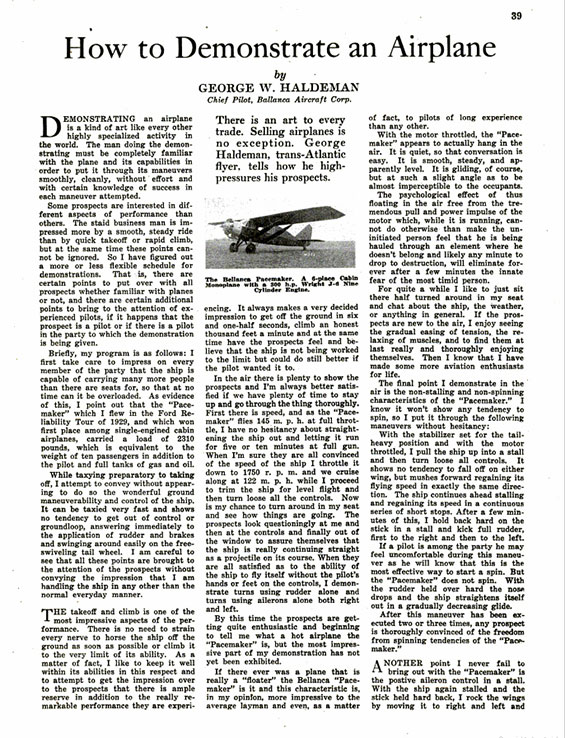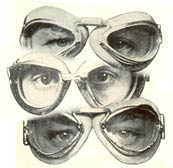|
George Haldeman, date unknown
 |
According to the Blue Book of Aviation of 1932 (citation,
left sidebar) George Haldeman was born July 28, 1898 at McPherson,
KS. His family moved to Lakeland, FL where George finished
high school in 1916. He was married in Lakeland on
November 13, 1920.
He entered the U.S. Army air service during WWI and attended
the School of Military Aeronautics at Austin, TX and was
assigned to Wright Field, Dayton, OH as an instructor in
aerial aerobatics. He pursued further training in
aerobatics and graduated after the war with an advanced aerobatics
certification from Carlstrom Field, Arcadia, FL. He
rose to the rank of 1st Lieutenant and became an instructor
and later an engineering officer in charge of engine and
propeller overhaul at Dorr and Carlstrom Fields in Arcadia. He
left the service in 1919.
Upon return to civilian life, he had his hands in numerous
entrepreneurial efforts. He operated flying schools
in various parts of Florida (Ruth Elder, see below, was one
of his students). He barnstormed through the southeastern
states, carrying passengers, giving wing-walking exhibitions
and parachute jumps. He distributed Curtiss and Waco
aircraft in Florida from 1919 to 1927.
In 1921 he made one of the first trans-continental flights
from Florida to California. From 1922-24 he owned
and operated the Dixie Highway Garage at Lakeland, FL (still in business as of the upload date of this page). During
1925 he was pilot-salesman for the Stinson Aircraft Corp.
On October 11-13, 1927 he attempted a trans-Atlantic flight
with Ruth Elder in a Stinson cabin land monoplane named “The
American Girl”. The flight was from Roosevelt
Field in New York, but engine trouble forced them to land
in the ocean alongside a ship some 350 miles off the Azores. They
were taken aboard and the flight was discontinued. Please
follow this link for
images of Haldeman and Elder relevant to their attempted
trans-Atlantic flight.
In 1928, Haldeman was associated with the Schlee-Brock Aircraft
Corporation. Also in 1928, with Eddie Stinson, he broke
the world’s non-refueled endurance record at Jacksonville,
FL, remaining in the air for 53 hours and 27 minutes.
From 1928-1930 he was chief test pilot and technical advisor
for the Bellanca Aircraft Corp. He participated in
the 1928 National Ford Reliability Tour. In 1928, 1929 and 1930 he won first place for cabin type airplanes in the
National Air Races. Below, from the January, 1931 issue of Popular Aviation(PA), is an article written by Haldeman about demonstrating his Bellanca aircraft.
How to Demonstrate An Airplane, Popular Aviation, January, 1931 (Source: PA)
 |
I've left a couple of the interesting advertisements intact on the second page, below. Note there were 14,425 certificated pilots in the U.S. by the end of 1931.
How to Demonstrate An Airplane, Popular Aviation, January, 1931 (Source: PA)
 |
George Haldeman, June 25, 1936 (Source: Boedy's
Album)
 |
After breaking speed and altitude records, Haldeman returned
to his primary interest which was engineering. He
was test pilot for several aviation firms, engineering and
testing many of the safety features found on contemporary airplanes:
wing slots, flaps, brakes and controllable propellers.
At left, a snapshot from Boedy's Album taken June 25, 1936. He was flight testing for Bellanca at the time. The "QB" means he was a member of the Quiet Birdmen, a pilot organization that was and is reputed to be anything but quiet.
In 1936 Haldeman joined the Civil Aeronautics Administration (CAA)
and was aeronautical engineering inspector and eventually
rose to chief of the aircraft engineering division of the
CAA in Washington, DC. For years he kept on top of
structural and propulsion innovations, traveling abroad to
attend conferences and to test-fly the civil and military
aircraft of many nations.
In the U.S. he flew the new Boeing 707 jetliner, DC-8 and
others. With this experience he and his CAA team set
up the standards for safety for American manufacturers of
new jet and turbo-powered aircraft.
Haldeman landed at Tucson three times between 1926 and 1932. On
September 4, 1926 he landed flying a Waco airplane, registration
unknown. He carried a single passenger, H.E. Cornell. Based
at Winterhaven, FL, they were westbound from Lordsburg, NM to Spokane, WA. They remained in Tucson until the 6th
before continuing their journey.
He landed again on July 10, 1928. This time he was
a part of the 1928 National Ford Reliability Tour. He
flew Bellanca CH NX4050, accompanied by two passengers, C.A.
Supole and Henry Haut Sterling. They placed 14th in
the 1928 Tour. Haldeman placed 5th in 1929 Tour. You
may view at this link a moving picture film of the arrival at Tucson
of the 1928 Tour on July 10th.
Haldeman’s third visit to Tucson was on August 22,
1932. He flew Bellanca Skyrocket NC544V. In the
passenger column he wrote that he was carrying “3 modocs”. Follow
the link for some fun related to the Golden Age “modoc”. He
wrote in the Register, "Riding herd on Cord Cup Race".
George Haldeman held transport license #222. He was
a member of Quiet Birdmen, the National Air Pilots Assn.,
National Aeronautic Assn. and the Federation Aeronautique
Internationale. He passed away on September
10, 1982.
---o0o---
Dossier 2.1.95
UPLOADED: 04/07/07 REVISED: 03/11/08, 02/24/14, 06/21/14
|





